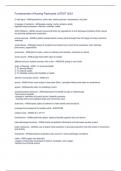Fundamentals of Nursing Flashcards LATEST 2024
5 vital signs - ANSrespirations, pulse rate, blood pressure, temperature, and pain
6 classes of nutrients - ANSsupply energy: carbs, proteins, lipids
regulate body processes: vitamins, minerals, water
ACE inhibitors - ANSto prevent vasoconstriction by angiotensin II and decrease circulatory fluid volume
by reducing aldosterone production
active exercise - ANSthe patient independently moves joints through their full range of motion (isotonic
exercise)
acute illness - ANSrapid onset of symptoms and lasts only a short time; examples: cold, diarrhea,
pneumonia, appendicitis
acute pain - ANSrapid in onset, varies in intensity and duration, protective in nature
acute wound - ANSusually heal within days to weeks
afferent nervous system conveys info to the - ANSCNS; going to your brain
Aims of Nursing - ANS1. To promote health
2. To prevent illness
3. To restore health
4. To facilitate coping with disability or death
albumin normal lab values - ANS3.5-5
anuria - ANS24-hour urine output is less than 50mL; complete kidney shut down or renal failure
apnea - ANSperiods when no breathing occurs
assessing blood pressure - ANS-listening for korotkoff sounds w/ stethoscope
-first sound is systolic
-change or cessation of sound occurs: diastolic pressure
- brachial artery and popliteal artery are commonly used
autonomy - ANSrespect rights of patients to make health care decisions
average blood pressure for healthy adult - ANS120/80
axillary temp - ANS36.5 C, 97.7 F
beneficence - ANSbenefit the patient; balance benefits against risks and harms
beta-adrenergic blockers - ANSto block sympathetic stimulation and decrease cardiac output
body mechanics - ANSthe use of proper body positions to provide protection from the stress of movement
and activity
bradypnea - ANSdecreased respiratory rate; occurs in some pathologic conditions
carbs - ANS-sugars and starches
-organic compounds composed of carbon, hydrogen, and oxygen
-lactose is an animal source
, Fundamentals of Nursing Flashcards LATEST 2024
-most abundant and least expensive
-classified as simple or complex sugars
-converted to glucose for transport through blood
-50-100g needed daily to prevent ketosis
chronic illness - ANSslow onset, characteristics: permanent change, caused by change in anatomy,
requires special patient education, long period of care or support; examples: heart disease, diabetes, lung
diseases, and arthritis
chronic pain - ANSpain that may be limited, intermittent, or persistent but that lasts beyond the normal
healing period
chronic wound - ANSdo not progress through stages of healing; healing impeded
Clara Barton - ANSestablished red cross; volunteered to care for wounds and feed union soldiers during
civil war; served as supervisor of nurses for the army of James
cleaning a pressure ulcer - ANSclean w/ each dressing change, gentle motions (patting), use 0.9%
normal saline solution to irrigate and clean, report any drainage or necrotic tissue
closed drainage system - ANS-Jackson-pratt drain
-hemovac drain
may be connected to an electrical suction or built-in reservoir
closed wound - ANSresults from a blow, force, or strain caused by trauma such as a fall, an assault, or
motor vehicle crash
color classification of open wounds - ANS-R: red-protect
-Y: yellow-cleanse
-B: black-debride
-mixed wound: contains components of RY&B wounds
colostomy - ANSpermits formed feces in the colon to exit through the stoma
constipation - ANSdry, hard stool; persistently difficult passage of stool; incomplete passage of stool
coping with disability and death - ANSnurses use optimal function of maximum strengths and potentials,
refer to community support systems; provide care to families and patients during end-of-life care, hospice
debridement - ANSremoval of devitalized tissue and foreign material
deductive reasoning - ANSexamines a general idea and then considers specific actions or ideas
Dehiscence - ANSBursting open of a wound, especially a surgical abdominal wound
desiccation - ANSdehydration
dialysis - ANSa mechanical way of filtering waste from the blood
diffusion - ANSexchange of oxygen and carbon dioxide between the alveoli of lungs and circulating blood
direct studies - ANSgoing inside the body ex. colonoscopy, sigmoidoscopy




